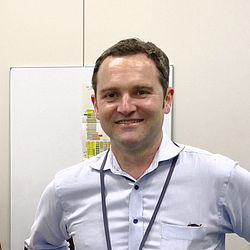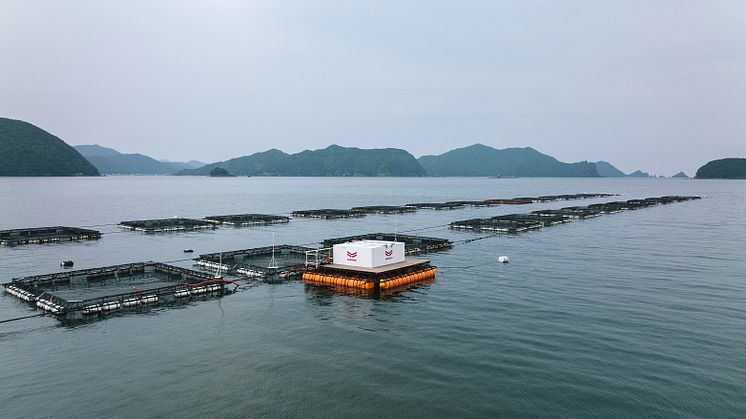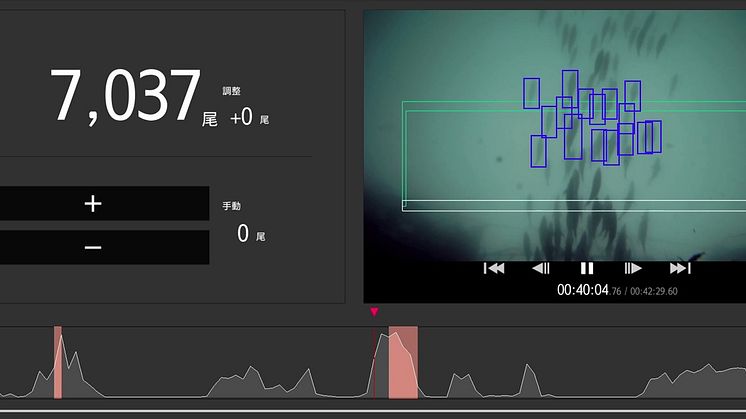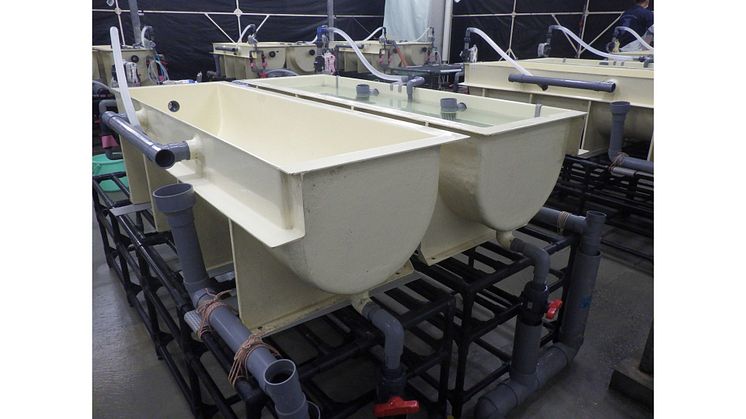
Press release -
Yanmar Collaborates on Mass-Production Eel Seedling Tank to Reduce Production Costs
Osaka, Japan (July 11, 2025) — The Japan Fisheries Research and Education Agency (FRA), Yanmar Holdings Co., Ltd. (Yanmar HD), and Marino-Forum 21 have jointly developed a new tank for the mass production of Japanese eel (Anguilla japonica) seedlings. This initiative is part of a Fisheries Agency-commissioned project titled “Demonstration of Mass-Production System for Commercialization of Eel Seedlings.” The newly developed tank successfully produced approximately 1,000 glass eels* per tank and achieved a significant reduction in rearing costs.
(*A glass eel is the translucent juvenile stage of some eel species.)
The new tank is made of fiber-reinforced plastic (FRP), making it more cost-effective and suitable for mass production compared to conventional acrylic or polyvinyl tanks. Future enhancements, including improved tank design, more advanced rearing methods, and the development of an automatic feeding system, are expected to facilitate the broader implementation of artificially produced eel seedlings. The results of this research have been patented under the title “Tank and Device for Rearing Fish Larvae.”
1. Roles of Each Organization
• Japan Fisheries Research and Education Agency: Designed the original tank concept, conducted rearing trials, and evaluated performance.
• Yanmar Holdings Co., Ltd.: Conducted flow field simulations, tank design, and manufacturing.
• Marino-Forum 21: Lead organization for the Fisheries Agency project; responsible for overall project planning, management, and tank development.
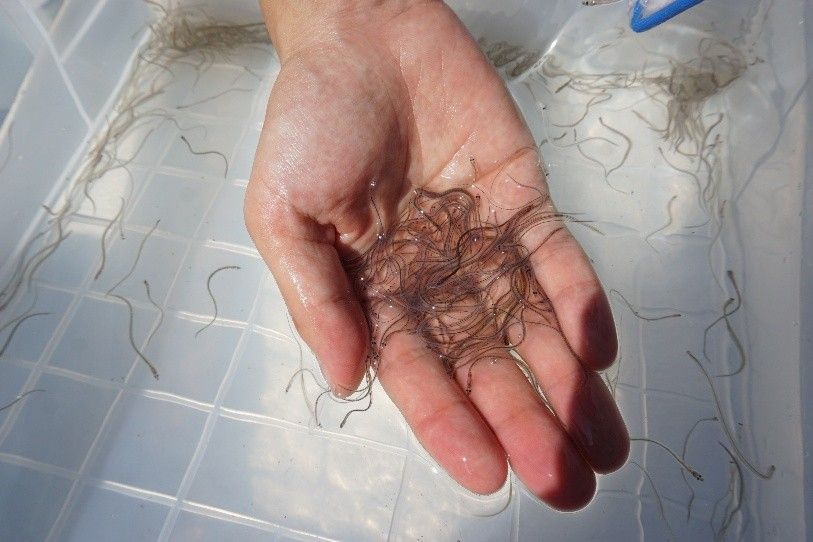
2. Background
Since the world’s first artificial hatching of Japanese eel larvae by Hokkaido University in 1973, numerous institutions have pursued eel larviculture. FRA’s predecessor developed a method in the early 1990s using shark egg-based feed and 5-liter acrylic bowl tanks (patented as Method for Rearing Hatched Eel Larvae, Patent No. 2909536). These innovations led to the world’s first successful artificial seedling production of eels in 2002, followed by full-cycle aquaculture—including breeding of parent eels produced from artificial seedlings—in 2010.
However, eel aquaculture still largely relies on wild glass eel collection, which has become increasingly scarce and expensive. To address this, FRA, Yanmar HD, and Marino-Forum 21 launched a Fisheries Agency project in 2017 to develop a mass production system that could support the commercialization of artificial eel seedlings.
Traditional rearing tanks (5–20 liters) yielded only 20–80 glass eels per tank. A larger, 1,000-liter semicylindrical tank was previously developed, but production per tank remained in the hundreds—less efficient per volume than small tanks. Moreover, tanks made from acrylic or PVC were costly and difficult to produce at scale. This highlighted the need for a more efficient and affordable tank for mass production.
3. Research Details and Significance
Most existing eel larval tanks are horizontally oriented cylinders with an open top. Researchers tested six tank variations with differing diameters and lengths to analyze their impact on eel growth and survival. Results showed that increasing the diameter beyond 50 cm reduced growth and survival rates, while extending the tank’s length had no adverse effects and allowed more larvae to be reared.
Using these findings and Yanmar HD’s fluid analysis, the team designed a new tank measuring 40 cm in diameter and 150 cm in length. Short-term rearing trials demonstrated that growth and survival rates matched or exceeded those in small tanks, with the ability to consistently rear thousands of larvae.
Recognizing the need for scalable, low-cost production, the team adopted FRP for the tank material due to its durability and affordability. The structure was refined for simplified assembly and operational ease. Two long-term trials confirmed the new tank could produce around 1,000 glass eels per tank. The production efficiency per volume was comparable to smaller tanks.
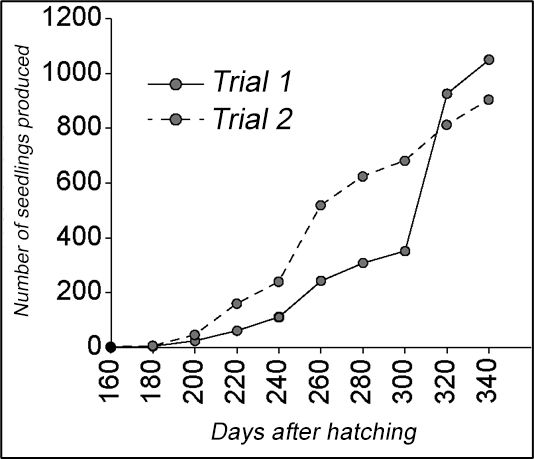
With approximately four tanks manageable per operator and a drastically lower production cost per eel—estimated to be one-twentieth that of previous large tanks—the new design is expected to become a foundational technology for large-scale eel seedling production. Plans are also underway with Yanmar Group to commercialize the tanks.
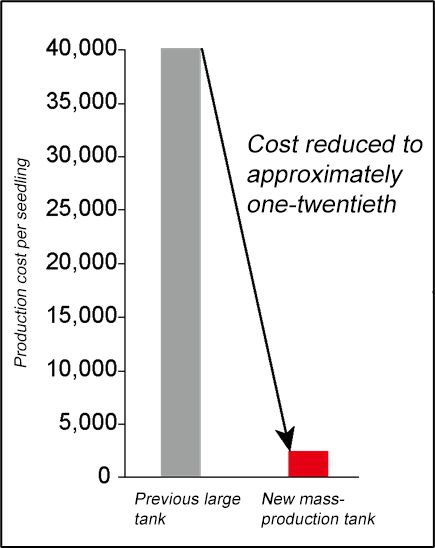
This innovation is patented in Japan as “Tank and Device for Rearing Fish Larvae” (Patent No. 7606689, registered December 18, 2024), and the details are publicly available on the Japan Platform for Patent Information (J-PlatPat).
Patent link: https://www.j-platpat.inpit.go.jp/c1801/PU/JP-7606689/15/ja
4. Future Outlook
To further reduce glass eel production costs and enable large-scale seedling supply, ongoing efforts will focus on larger tanks, advanced rearing technologies, automation, and energy-efficient systems. These efforts are part of the 2023 Fisheries Agency project “Practical Application of Mass Production Systems for the Commercialization of Eel Seedlings,” which aims to make affordable, high-volume artificial eel production a reality.
Definitions:
- Artificial seedling production: The process of inducing maturation in parent eels and raising the resulting eggs into glass eels suitable for aquaculture.
- Full-cycle aquaculture: Producing a new generation of artificial seedlings from eels that were themselves reared from artificial seeds.
Published Research Paper:
Title: The development of a new tank for mass production of eel seedlings.
Authors:
Ryusuke Sudo, Takashi Yatabe, Masataka. Satomi, Ryutaro Takasaki (FRA)
Keisuke Uezumiya (Yanmar HD), Mitsuo Takahashi (Marino-Forum 21), Kazuharu Nomura (FRA), Hideki Tanaka (FRA, Kindai University)
Journal: Fisheries Science
About Yanmar
With beginnings in Osaka, Japan, in 1912, Yanmar was the first ever to succeed in making a compact diesel engine of a practical size in 1933. A pioneer in diesel engine technology, Yanmar is a global innovator in a wide range of industrial equipment, from small and large engines, agricultural machinery and facilities, construction equipment, energy systems, marine, to machine tools, and components — Yanmar’s global business operations span seven domains. On land, at sea, and in the city, Yanmar provides advanced solutions to the challenges customers face, towards realizing A Sustainable Future. For more details, please visit the official website of Yanmar Holdings Co., Ltd.
https://www.yanmar.com/global/about/
Related links
Topics
Categories
Note: Information contained in the news release is valid at the time of publication and may differ from the most recently available information.
[Inquiries for further information]
Corporate Communications, Yanmar

